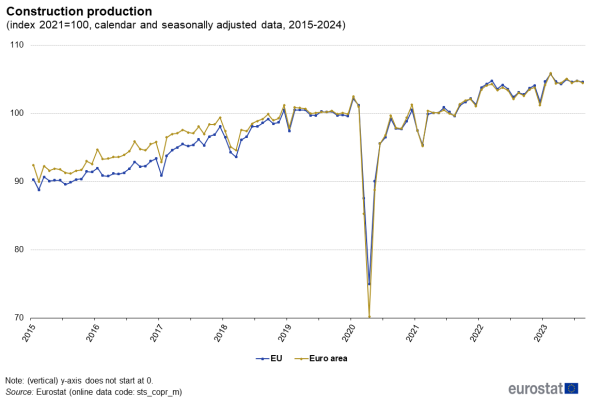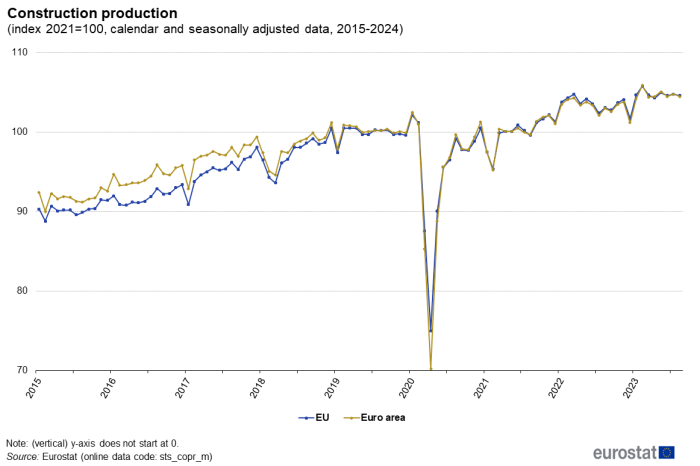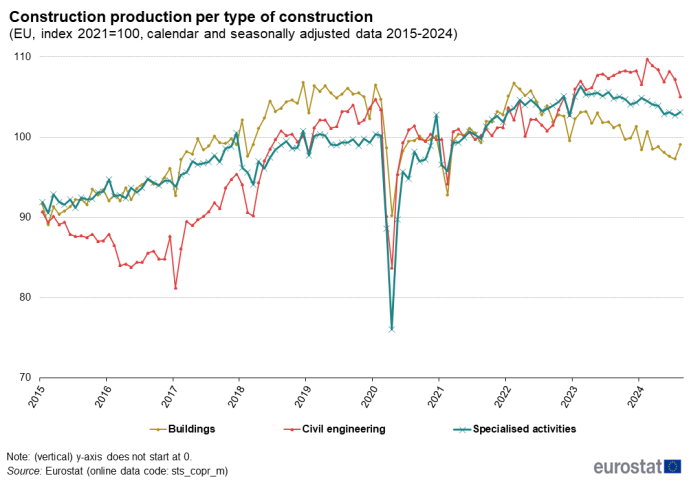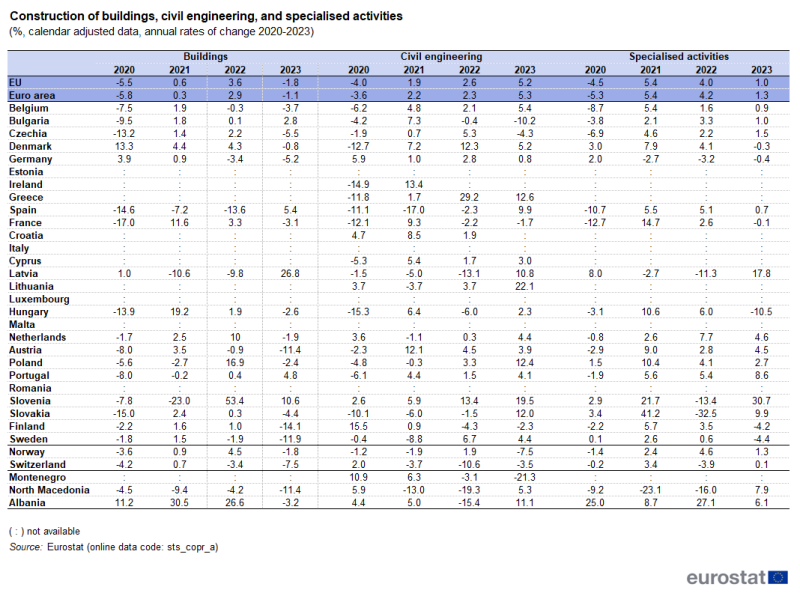Data extracted in October 2024.
Planned article update: October 2025.
Highlights

The production index for construction is a business cycle indicator which measures monthly changes in the price adjusted output of construction. The construction production index corresponds to the industrial production index but covers NACE section F.
Please also see the monthly Eurostat News Release from 20 May 2025.
Construction output in Europe
Following the economic and financial crisis 2008/2009, construction production in the EU had been on a steady downturn until the year 2013. After about 2 years of stagnation, the construction index began to climb again for the next years. In March and April 2020, the index declined dramatically and lost more than 25 percentage points (pp) in just 2 months. In May 2020 a recovery set in, yet, construction production only regained its pre-Covid-19 level about a year and a half later. The development in the euro area is quite similar to the development of the EU (Figure 1).

Source: Eurostat (sts_copr_m)
There are some noticeable differences between the development of the construction of buildings (residential and non-residential), the development of the construction of civil engineering works (e.g. railways, roads, bridges, airport runways, dams) and the development of other specialised construction works. When building construction and specialised activities picked up in the years 2015-2017, civil engineering was still on a downward path. Over recent years however, civil engineering developed in a comparatively dynamical way (Figure 2).

Source: Eurostat (sts_copr_m)
Between 2015 and 2019 construction production in the EU increased by a total of around 10% (8% in the euro area). Particular positive developments were recorded in Cyprus where construction doubled, and in Hungary and Ireland where construction increased by more than half. In Greece and Portugal production levels decreased.
Mainly as a result of the Covid-19 pandemic and the resulting containment measures, construction activities dropped massively in 2020 (-4.9% in the EU and -5.6% in the euro area). A large majority of countries registered a negative rate of change. Some countries however, increased activities during the year of the pandemic, i.e. Denmark, Germany, Croatia, Latvia, and Malta. In Romania construction activities even increased by 16%.
During the past 3 years, 2021-2023, construction production developed relatively dynamically (more than 10% increase in the EU and the euro area). The production increases were particularly strong in Italy (more than 60%) and in Greece (50%). Quite a number of countries however, registered a decline in construction activities, i.e. Germany, Spain, Latvia, Slovakia, Finland, Sweden (Table 1).

Source: Eurostat (sts_coprgr_a)
Table 2 provides a breakdown of the total construction into building construction, civil engineering work, and specialised construction activities for the recent four years. In most countries the construction of buildings and specialised activities were more strongly affected by the Covid-19 pandemic than civil engineering work. In a number of countries, the latter even increased in 2020. In 2021, all sectors recorded relatively strong growth rates. In 2022, rates were somewhat lower but the overall development was still quite dynamic. In 2023 construction production only increased at a moderate pace in general and even declined in many countries for building construction.

Source: Eurostat (sts_coprgr_a)
Source data for tables and graphs
Data sources
The obligation to transmit construction production data to Eurostat is laid down in Regulation (EU) No 2019/2152 of 27 November 2019 (European Business Statistics Regulation) and in the Commission Implementing Regulation (EU) No 2020/1197 of 30 July 2020. Like the industrial production index the construction production index is intended to reflect the monthly volume value added of the construction sector. This variable is however not directly observable and must therefore be approximated by other measures such as deflated gross production or input of labour and raw materials.
Eurostat publishes, on a monthly basis, the construction production index for the EU, for the euro area and the Member States; data are also collected for Norway, Switzerland, Bosnia and Herzegovina, Montenegro, North Macedonia, Albania, and Serbia. Data are presented in calendar adjusted/working-day adjusted and in seasonally adjusted form. Rates of change are also available. The data in this article were calculated with the base year 2021 (2021 = 100).
Context
The EU construction sector accounts for more than 5 % of (gross) value added. Although the relative share of construction in Europe's economic activity has declined over recent years, construction is still of high importance for European economies. The indices for the development of construction output is therefore an important tool for the European Central Bank and the national central banks for monitoring and analysing economic developments. Production in construction is one of the so-called 'Principal European Economic Indicators (PEEI)' which are used to monitor and steer economic policy in the EU and in the euro area.
Explore further
Other articles
Database
- Construction, building and civil engineering (sts_cons)
- Production in construction (sts_cons_pro)
Thematic section
Publications
- EU-27 construction activity falls by 16% from its pre-crisis high by the second quarter of 2011, Statistics in focus 61/2011
- An international comparison of short-term statistics, Statistics in focus 53/2011
- An analysis of building construction based on building permits, Statistics in focus 55/2010
- A decade and more of monthly construction statistics, Statistics in focus 129/2007
Selected datasets
- Construction, building and civil engineering (NACE F) (t_sts_cons)
- Production in construction (teiis500)
Methodology
- European business statistics methodological manual for compiling the monthly index of production in construction – 2021 edition
- European Business Statistics Manual – 2021 edition
- Short-term business statistics - Metadata in SDMX format (ESMS metadata file — sts_esms)
- More information on Metadata in Eurostat
